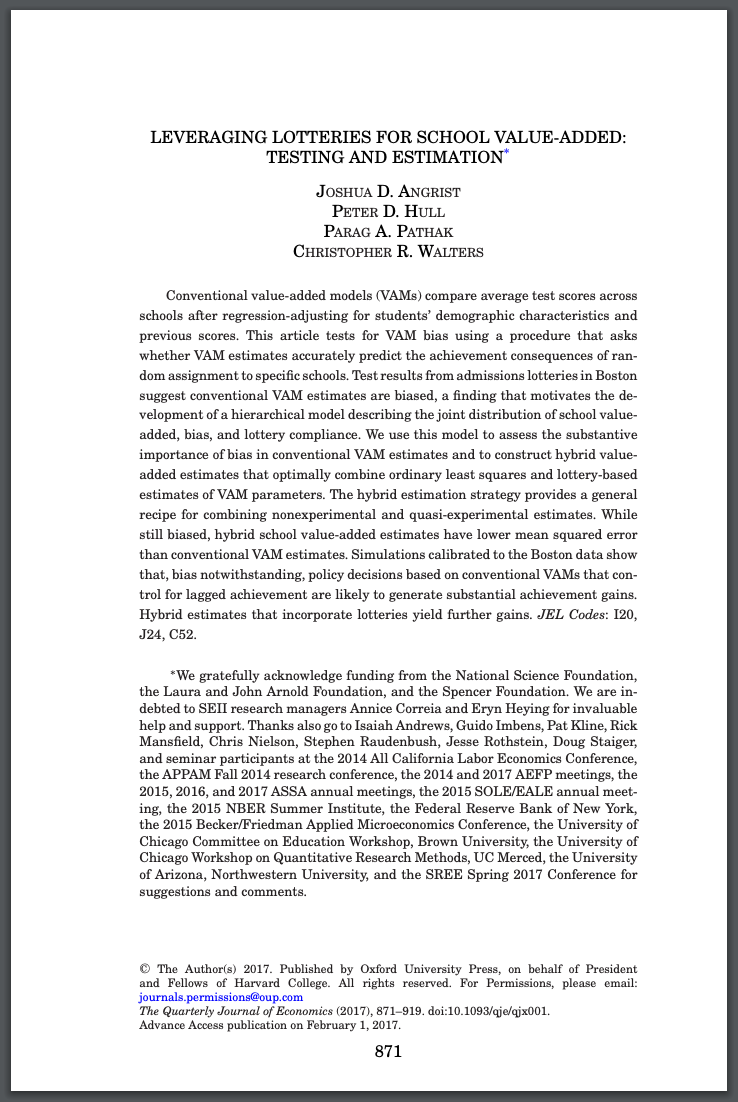
News and Publications

Who Gets the Ventilator?
Should a nurse or doctor who gets sick treating Covid-19 patients have priority access to a potentially life-saving healthcare device? Americans aren’t used to rationing in medicine, but it’s time to think about it. We consult a lung specialist, a bioethicist, and (of course) an economist.

Parag Pathak Named Top Scientist To Watch

Parag Pathak uses data and algorithms to make public education fairer
After designing school choice systems, he’s studying student performance

How an Economist Unlocked Hidden Truths About School Choice
It all begins with an idea.

Breaking Ties: Regression Discontinuity Design Meets Market Design
Abdulkadiroğlu, Atila, Joshua D. Angrist, Yusuke Narita, and Parag A. Pathak. SEII Discussion Paper #2018.01 (2019).
Centralized school assignment algorithms must distinguish between applicants with the same preferences and priorities. This is done with randomly assigned lottery numbers, non- lottery tie-breakers like test scores, or both. The New York City public high school match illustrates the latter, using test scores, grades, and interviews to rank applicants to screened schools, combined with lottery tie-breaking at unscreened schools. We show how to identify causal effects of school attendance in such settings. Our approach generalizes regression discontinuity designs to allow for multiple treatments and multiple running variables, some of which are randomly assigned. Lotteries generate assignment risk at screened as well as unscreened schools. Centralized assignment also identifies screened school effects away from screened school cutoffs. These features of centralized assignment are used to assess the predictive value of New York City’s school report cards. Grade A schools improve SAT math scores and increase the likelihood of graduating, though by less than OLS estimates suggest. Selection bias in OLS estimates is egregious for Grade A screened schools.

Reserve Design: Unintended Consequences and the Demise of Boston’s Walk Zones
Dur, Umut, Scott Duke Kominers, Parag A. Pathak, and Tayfun Sönmez. Journal of Political Economy 126, no. 6 (2018): 2457-2479.
We show that in the presence of admissions reserves, the effect of the precedence order (i.e., the order in which different types of seats are filled) is comparable to the effect of adjusting reserve sizes. Either lowering the precedence of reserve seats at a school or increasing the school’s reserve size weakly increases reserve-group assignment at that school. Using data from Boston Public Schools, we show that reserve and precedence adjustments have similar quantitative effects. Transparency about these issues—in particular, how precedence unintentionally undermined intended policy—led to the elimination of walk zone reserves in Boston’s public school match.

Parag Pathak Wins Clark Medal
Parag Pathak’s research has lead to significant improvement in the assignment of students to public schools. For that work, he is awarded the prestigious John Bates Clark Medal by the American Economic Association.

Research Design Meets Market Design (Econometrica 2017)
A growing number of school districts use centralized assignment mechanisms to allocate school seats in a manner that reflects student preferences and school priorities. Many of these assignment schemes use lotteries to ration seats when schools are oversubscribed. The resulting random assignment opens the door to credible quasiexperimental research designs for the evaluation of school effectiveness. Yet the question of how best to separate the lottery-generated randomization integral to such designs from non-random preferences and priorities remains open. This paper develops easily-implemented empirical strategies that fully exploit the random assignment embedded in a wide class of mechanisms, while also revealing why seats are randomized at one school but not another. We use these methods to evaluate charter schools in Denver, one of a growing number of districts that combine charter and traditional public schools in a unified assignment system. The resulting estimates show large achievement gains from charter school attendance. Our approach generates efficiency gains over ad hoc methods, such as those that focus on schools ranked first, while also identifying a more representative average causal effect. We also show how to use centralized assignment mechanisms to identify causal effects in models with multiple school sectors.

Leveraging Lotteries for School Value-added: Testing and Estimation
Angrist, Joshua D., Peter D. Hull, Parag A. Pathak, and Christopher R. Walters. The Quarterly Journal of Economics 132, no. 2 (2017): 871-919.
Conventional value-added models (VAMs) compare average test scores across schools after regression-adjusting for students’ demographic characteristics and previous scores. This article tests for VAM bias using a procedure that asks whether VAM estimates accurately predict the achievement consequences of random assignment to specific schools. Test results from admissions lotteries in Boston suggest conventional VAM estimates are biased, a finding that motivates the development of a hierarchical model describing the joint distribution of school value- added, bias, and lottery compliance. We use this model to assess the substantive importance of bias in conventional VAM estimates and to construct hybrid value- added estimates that optimally combine ordinary least squares and lottery-based estimates of VAM parameters. The hybrid estimation strategy provides a general recipe for combining nonexperimental and quasi-experimental estimates. While still biased, hybrid school value-added estimates have lower mean squared error than conventional VAM estimates. Simulations calibrated to the Boston data show that, bias notwithstanding, policy decisions based on conventional VAMs that control for lagged achievement are likely to generate substantial achievement gains. Hybrid estimates that incorporate lotteries yield further gains.

A New Way to Measure the Impact of Charter Schools
Do charter schools improve their students' test scores and later life outcomes? This can be a tough question to answer because even when charter school students succeed, it's not always clear that the charter school is what's responsible. Most researchers have studied results from charter school admissions lotteries, but critics worry that these studies don't tell us anything about how the vast number of students who don't wind up in admission lotteries would do in charter schools. In a study appearing in the July issue of the American Economic Review, authors Atila Abdulkadiroğlu, Joshua Angrist, Peter Hull, and Parag Pathak develop a new approach that can tell us more about how different kinds of students respond to charter education.

More on That Study of Bayou Charter Schools

New Orleans Takeover

How Game Theory Helped Improve New York City’s High School Application Process
It all begins with an idea.

School Admissions Reform in Chicago and England: Comparing Mechanisms by their Vulnerability to Manipulation
Pathak, Parag A., and Tayfun Sönmez. American Economic Review 103, no. 1 (2013): 80-106.
In Fall 2009, Chicago authorities abandoned a school assignment mechanism midstream, citing concerns about its vulnerability to manipulation. Nonetheless, they asked thousands of applicants to re-rank schools in a new mechanism that is also manipulable. This paper introduces a method to compare mechanisms by their vulnerability to manipulation. Our methodology formalizes how the old mechanism is at least as manipulable as any other plausible mechanism, including the new one. A number of similar transitions took place in England after the widely popular Boston mechanism was ruled illegal in 2007. Our approach provides support for these and other recent policy changes.

Simulating Alternative School Choice Options in Boston-Main Report
Pathak, Parag A., and Peng Shi. (2013).
This report evaluates alternative school choice options for Boston Public Schools (BPS) using demand analysis based on historical data on families’ choices under the Boston student assignment plan. Using demand estimates, we evaluate the proposed alternative assignment plans by simulating how families would choose schools in these plans and how this interacts with the assignment algorithm. Our approach is to examine what would have happened in Round 1 of 2012-2013 had a new assignment plan been implemented in that year.

